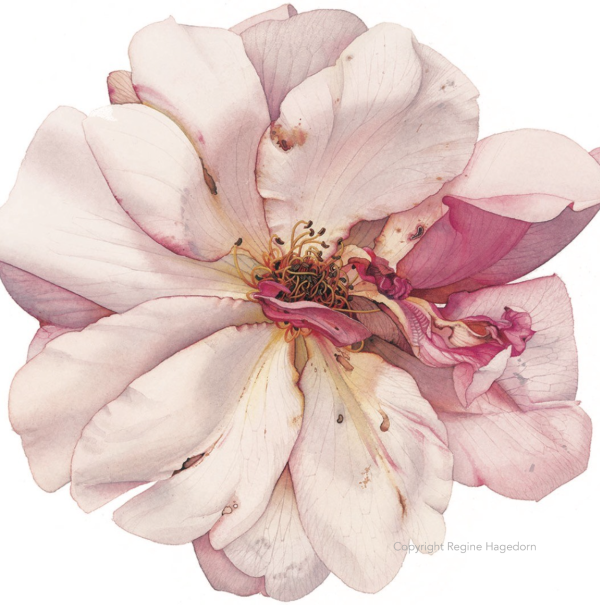While working on my latest e-booklet on watercolour techniques for botanical art, I was looking for images by artists whose work offers information on the process they use, while at the same time speaking to an identifiable style. In other words, I wanted works that both tell a story about style and accuracy of content while also instructing in core skills that lead to success in this unique genre.
French artist, Regine Hagedorn, immediately came to mind. Regine has been among my top five favorite botanical artists ever since I saw her work in person at the opening of the Shirley Sherwood Gallery in Kew Gardens in 2008. Her rose studies appear to be a haphazard arrangement of plant parts—flowers, rosehips, leaves, thorny stems—but they are in fact very carefully arranged elements by a masterful designer with experience in contemporary jewelry design where, as in botanical art, shape, simplicity and detailing really matter.
Regine’s works are not brilliant in the way of Redouté’s complex and graceful flower stems, nor in the way of Pandora Sellars’s intricate, strongly-contrasted theatrical compositions. Instead, her uniqueness of style captivates in an entirely opposite and different way; it lies in the power of the focused simplicity of content and technique. Her work dazzles in the purity of her colour use with the skillful capture of edges. Her pieces are incredible gems that include the apparent looseness of wet and surface-blended colour, finished with exquisite detailing of tiny components and textures in dry brush work.
As time passed and I saw more of Regine’s work, I realized that it embodies a unique and powerful statement for botanical artists wishing to control watercolour in simple ways that speak volumes.
So, I hope that my latest e-booklet encourages success in botanical art in watercolour with a focused or renewed intensity. Practise is of course the key to acquiring the core skills of solving water and pigment control in simple shapes and subjects. Discover which techniques works for you and which do not. Through continual practice, you’ll see an identifiable style emerge. Not Regine’s, not anyone else’s, but yours.
Regine is supportive of botanical art learning and generously allowed me to include her work with this post and in my upcoming e-booklet.
You can see more of her inspiring work on Instagram at @reginehagedorn

